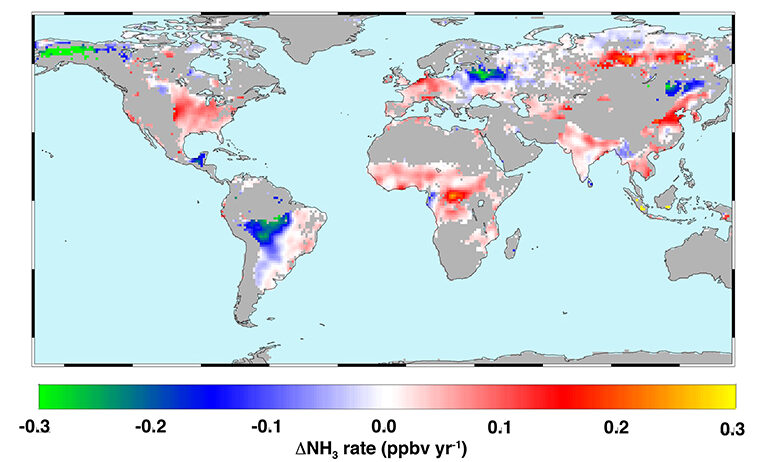Ammonia (NH₃) is a compound that plays a multifaceted role in the environment, particularly regarding its interaction with climate change. It is widely utilized in agriculture as a fertilizer and is also a byproduct of various industrial processes. While ammonia itself is not a direct greenhouse gas like carbon dioxide (CO₂) or methane (CH₄), understanding its potential impact on global warming is crucial, particularly when considering its ability to contribute to secondary pollutants and its relationship with other greenhouse gases.
To determine whether ammonia has the highest global warming potential, it’s essential to elucidate the concept of Global Warming Potential (GWP). GWP is a measure of how much heat a greenhouse gas traps in the atmosphere over a specific timeframe, usually 100 years, compared to carbon dioxide. For instance, methane has a GWP of approximately 28-36 times that of CO₂ over that period, whereas nitrous oxide possesses a GWP of about 298 times that of CO₂. In contrast, ammonia itself does not possess a GWP in the traditional sense because it is not a stable greenhouse gas; rather, its impacts are indirect and more complex.
When considering ammonia’s role in the atmosphere, it is paramount to recognize its transformation and interaction with other pollutants. Ammonia can undergo chemical reactions that lead to the formation of particulate matter—specifically ammonium sulfate and ammonium nitrate. These particulates can contribute significantly to atmospheric processes, often resulting in adverse health effects and changes in climate dynamics. Notably, fine particulate matter (PM2.5) has been linked to various respiratory ailments and cardiovascular diseases, posing significant risks to human health.
Moreover, ammonia emissions contribute to the formation of ground-level ozone, a potent greenhouse gas that exacerbates climate change. This transformation occurs when ammonia reacts with other pollutants, such as nitrogen oxides (NOₓ). The resultant ozone holds a GWP considerably higher than CO₂, highlighting ammonia’s indirect contributions to warming.
It is also imperative to discuss the agricultural sector, which is the largest source of ammonia emissions. Fertilizer application, particularly synthetic fertilizers, releases ammonia into the atmosphere, contributing substantially to the nitrogen cycle’s disturbances. High nitrogen use efficiency in fertilizers could ameliorate some of these emissions, but challenges in adoption remain. Sustainable farming practices, such as precision agriculture, can optimize fertilizer application and thereby minimize ammonia loss, showcasing a viable solution to mitigate its impact.
Climate models over the past few decades have explored the interactions between different greenhouse gases, emphasizing the importance of considering ammonia in conjunction with other nitrogen compounds. Nitrous oxide emissions, although numerically smaller than ammonia from agriculture, exert a much more substantial warming effect. The interlinked nature of the nitrogen cycle and its atmospheric effects necessitates comprehensive strategies to regulate ammonia emissions while also addressing nitrous oxide sources effectively.
This complexity is further compounded by the geographical hotspots of ammonia emissions, which are primarily located near intensive agricultural operations. It is crucial to understand how these hotspots contribute to localized and global climate variations. Regions with high ammonia concentrations may experience altered weather patterns, ecosystem imbalances, and diminished air quality, ultimately affecting biodiversity and human health.
Policymakers face the arduous task of addressing these multifaceted issues. Strategies to reduce ammonia emissions must consider both ecological and health perspectives. Regulatory frameworks that promote the use of low-emission technologies in agriculture, alongside investment in research and development for innovative nitrogen management practices, are essential. Governments and industries alike must prioritize collaboration and enforce stringent policies that curb emissions effectively.
Education and awareness are also vital components in tackling the adverse effects of ammonia on climate change. Farmers, agricultural professionals, and the community must understand the implications of ammonia releases and the importance of adopting best practices. Outreach programs can facilitate the dissemination of knowledge about the impact of nitrogen management and its significance in fostering sustainable agricultural practices.
In conclusion, while ammonia does not hold the title of the greenhouse gas with the highest global warming potential in a direct sense, its contributions to overall climate change are significant through various indirect pathways. The interplay between ammonia and other pollutants amplifies its environmental impact, particularly in the context of agricultural practices and air quality. Addressing ammonia emissions, therefore, requires a multifaceted approach that encompasses technological innovation, sustainable farming practices, regulatory actions, and education. Only when a comprehensive strategy is adopted can we hope to mitigate the detrimental effects of ammonia on our climate.






